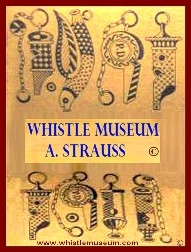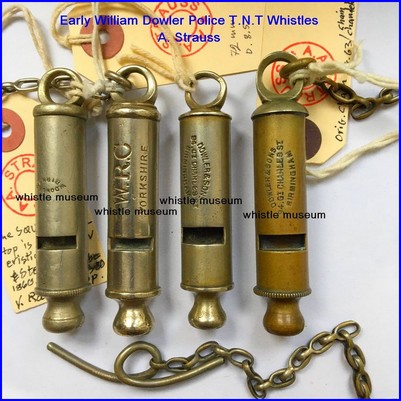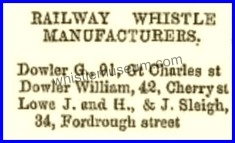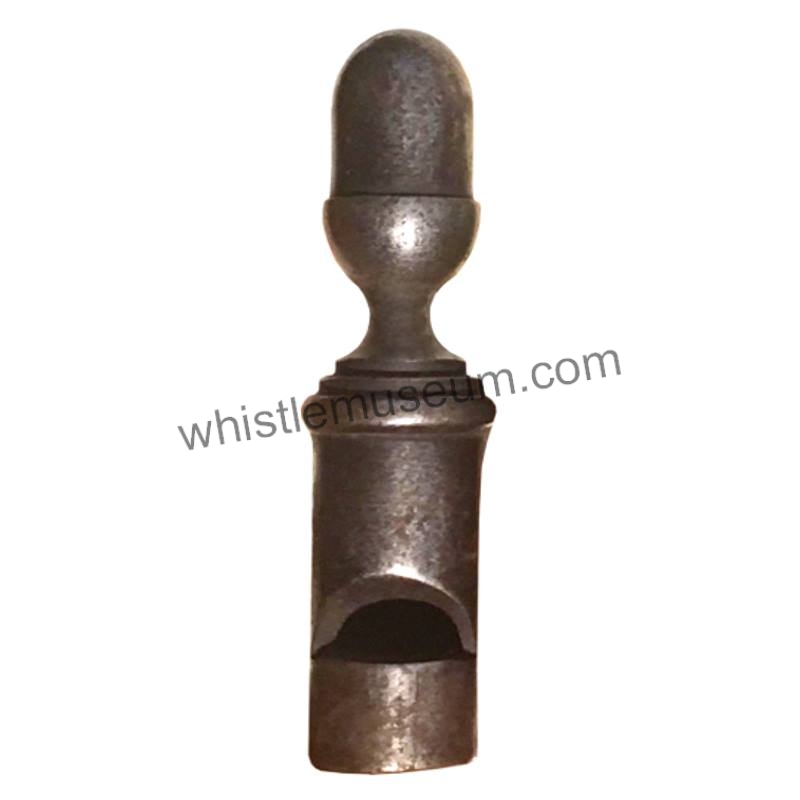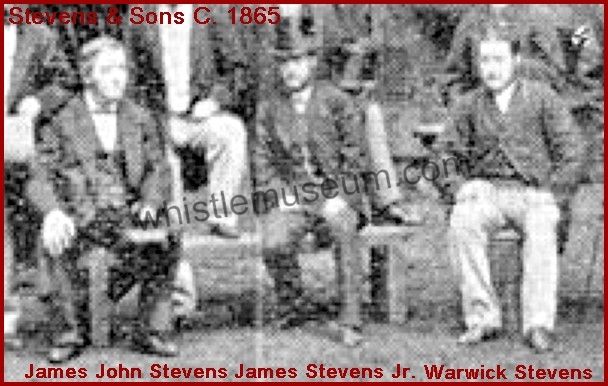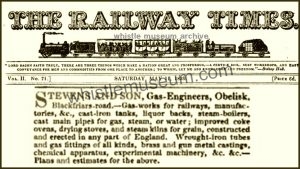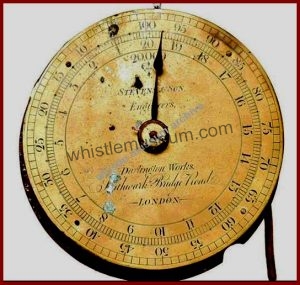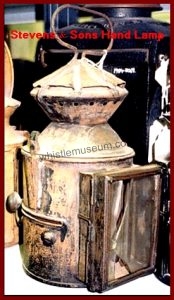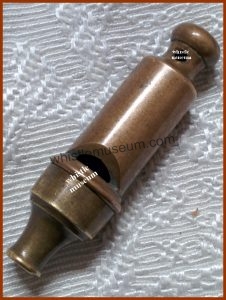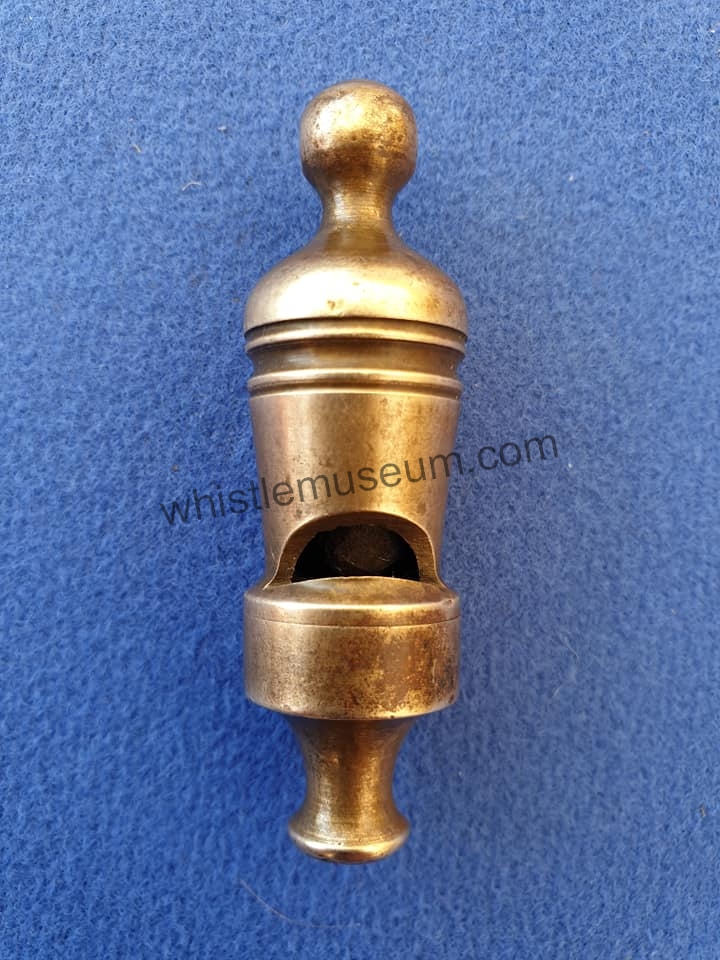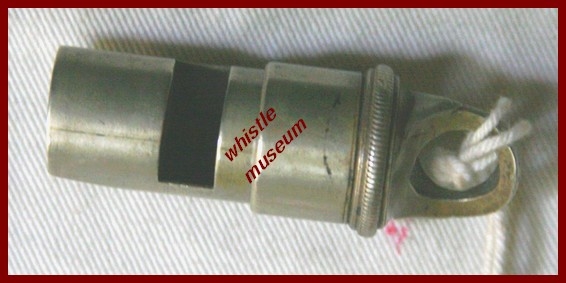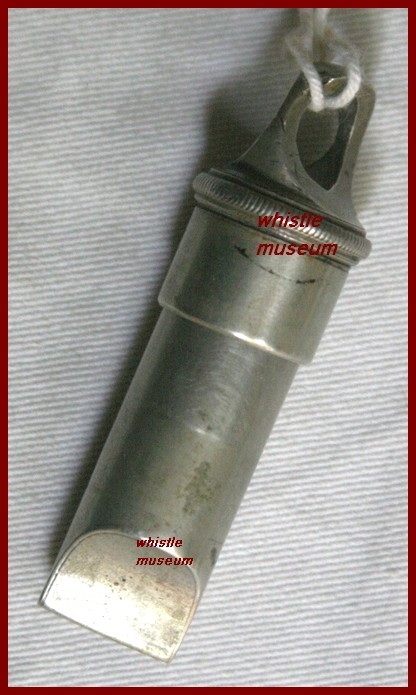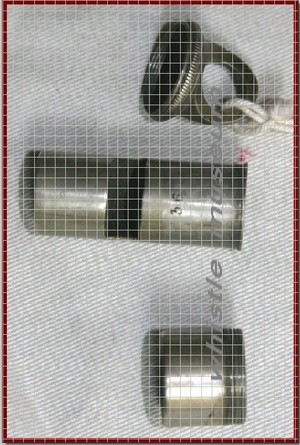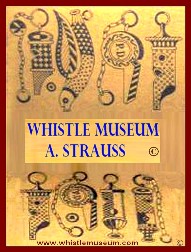Part I & II Part III
Intro
I first wrote Dowler’s history (AS whistle makers) in 2008
posted in Wikipedia and updated with more info whistle photos from my collection and articles updated later.*
It is updated and concise here as I omit much of the vast info and collected since.
The Dowler Family were Brass manufacturers since the 18th Century
established 1766 at 91 & 92 Gt. Charles Street Birmingham, later known as the Dowler’s Arm a small waterways on the Birmingham Fazeley Canal.
They may have earlier history as Brass founders.
It is the author belief they also made whistles in their earlier years
but this remains as an educated guess as of now.
The Essay is long and would be in Few Parts
Part 1 Brief History
Part 2 George Dowler
Part 3 William Dowler Manufacturing History, spun over 50 years, He is the DOWLER we know from his many whistles, Buttons, and Military ornaments.
The 3rd part shall be the most detailed part concerning WHISTLES.
William Dowler was the first pioneer to supply Police forces in England with a Force name with Two Notes Conical (TNC) Type Whistles (Also Known as Beaufort ).
It is divided to few sub – parts, and 6 periods.
Dealing with various whistle types.
General note regarding time line.
Mary Dowler was a dominant figure in the early part of the 19th century
Her sons George and William kept the business, 1816 Directory Clip.
In the 1840s George Dowler was running a successful manufacturing career being an inventor and maker of numerous brass goods.
In 1853 William Dowler opened his independent work shop in partnership with Charles Parker (D. 1852) daughter Marry Hanna Parker, in 42 Cherry St. Birmingham.
I shall start with George for a short paragraph since we can not identify the whistles he made at this point (One is identified), and then discuss William Dowler (Later & Sons) who is the one associated with whistle manufacturing among collectors.
General Early History
Dowler firm was established in 1776 in Birmingham.
we know this from George Dowler advertisements by Thomas Dowler, There are various brass founders named Thomas Dowler at the 2nd part of 18th century and since it was common to name the son after the father at times for few generations it is difficult to establish the accurate history so I leave this complex Geneaology research at this point. Thomas Dowler I 1752 -1805
Thomas Dowler I 1752 -1805
Mary Dowler 1755 – 1825
Had 7 Children :
Thomas Dowler II 1777 1852
Joseph Dowler 1779 1837
William Calley Dowler (The 1st) B. 1782 D. 1825
George Augustus Dowler 1781 1827
Sara Dowler 1826 – 1868
Mary Ann Dowler 1785 1851
Ann Robbins Dowler 1787 1868
Thomas Dowler (Son ) 1877 1852
Joseph Dowler 1779 1837 & Hanna Sadbury Dowler 1780 1866
Were the parents of the two famous whistle makers :
William Colley Dowler 1813 – 1888
George Dowler 1824 – 1901
William Colley Married Hanna Dowler (in 1850 ) their children
Arthur P. Dowler (B 1860) A Button Manufacturer
Thomas William Dowler A Jeweler & Button Manufacturer
Austall Edwin Dowler (B 1850)
The first two were the ones who joined the buisiness in 1866 (Dowler & Sons)
Thomas & Mary Dowler were the dominant figures in the early part of the 19th century, The family history is complex & perplexing, Listed as early as 1815 as
Mary Dowler & Sons and as Thomas Dowler both at Great Charles St. where the family business had been since the 18th Century, The address would be the main address for well over 100 years up to 1900.
George and William kept the business, 1815 Directory Clip
 Management of the Great Charles Street foundry passed down to Thomas Dowler who remained unmarried. He lived in the house attached to the foundry with three spinster sisters, Ann, Mary Ann and Sarah.
Management of the Great Charles Street foundry passed down to Thomas Dowler who remained unmarried. He lived in the house attached to the foundry with three spinster sisters, Ann, Mary Ann and Sarah.
George Dowler was a nephew who took over running the firm when Thomas
Dowler II died.
George added other trades to that of brass foundry
In 1830 we see Thomas Listed as Medalist and Manufacturer of plated Knives, Forks, Spoons, Nutcrackers, Skewers, Etc. Etc. Bell Founder, Fire Iron Maker, Brass and Princes metal candlestick maker, 91 Gt. Charles St.
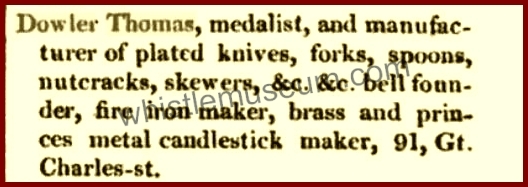
M (Marry) Dowler & Son, Great Charles Street, Birmingham,
candlestick maker. (Commercial Directory 1816-17)
Thomas Dowler, 91, Great Charles Street, Birmingham, brass fire furnishers and manufacturers. (Wrightson directory 1835)
In the later 1840s George Dowler, was running a successful manufacturing career being an inventor and maker of numerous brass goods, while his older brother William Dowler was distributing the family merchandise living in Soho Hill listed as a Traveler (1952)
In 1853 there is a ‘fork’ in the road and it became two different companies, Making some parallel goods, we shall start with George for a short paragraph and then discuss William Dowler.
The next 3 quotes are from a long article about DOWLER’s ARM found in 2006 upon a visit to the Birmingham Library, It was later available in full on the web.
“The increasing requirement for brass as a component in cartridges for the new breech loading rifles and bullets for handguns encouraged Dowler to also make chassepot cartridges. He also had cartridge-filling sheds at Tyburn, also near the Birmingham & Fazeley Canal.
George Dowler came to live at Knowle with his surviving aunt, Ann Robbins Dowler, who was the effective owner of the Great Charles Street Brass Foundry.
The vesta match was made by dipping wax taper in a phosphorus-rich mixture. It was an occupation that depended principally on the employment of young people and children and their prolonged exposure to the “white” phosphorus in the compound led to many being inflicted with the “Phosphorus Disease”. This horrible disease led to disfigurement and premature death.
Dowler’s Arm & Plume St.
William Dowler, military ornament and button maker of Birmingham, challenged George for control of the estate. In a rare instance two probates were proved independently by George and William. Ann Dowler had made several changes (codicils) to her will and in the final form William had joined George as executors of Ann’s estate. The dispute developed and in the Court of Chancery, the Great Charles Street Brass Foundry was offered for sale. It was a dispute that rumbled on through 1868 and 1869 to 1871 when William Dowler brought further actions and the matter was not finally settled until 1876.”
In 1858 William is listed Solo on 42 Cherry St as a Railway Whistle Maker.
==================
PART 2
==================
George Dowler 1824 – 1901
George Dowler was one of the largest manufacturers of Brass goods in Birmingham, Making Matchsticks and numerous Brass Goods from 1840s when he took over Thomas Dowler the son, He was the Brother of William Dowler who became one of the 4 large whistle makers in England up to the mid 1880s.
In his 20s he was running the business up to March 19, 1870, when his huge factory in Aston, employing over 500 man burnt to the ground. He also was an inventor and amateur musician. I will bring few important events in his life and few examples hopefully there will be more whistles found.
In 1876 he emigrated with his wife & sons to Ontario Canada to become a farmer
& died there at the age of 77.
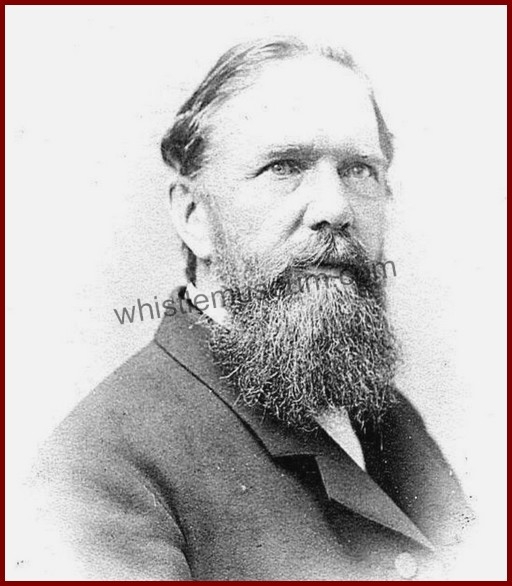
A speaking tube whistle with indicator made by George Dowler c. 1840s 50s, ,
a similar one without indicator was made as well, it is not a stamped one but identified by the top which is similar to his Nocturnal vesta patent of 1850.
Albeit this is the only one yet identified we know he made many types of whistles in the 50s and 60s, Including French Calls (Cast Base Metal or ? ),
Railway Guard Whistles (TNC two note conical later nick named Beaufort) &
Dog Calls (Which were round & pea whistles),
These types were advertised by him but I was not yet able to find any identifying features or stamps by which we can positively identify his whistles.
It is likely he made button whistles as well, if some will be found, they can be identified by his stamp on buttons, DOWLER BRIMINGHAM, (William his Brother stamped his as ‘W. Dowler’ and other particular stamps in various periods, see stamps in part III).
 Another view with SCREW TOP taken apart.
Another view with SCREW TOP taken apart.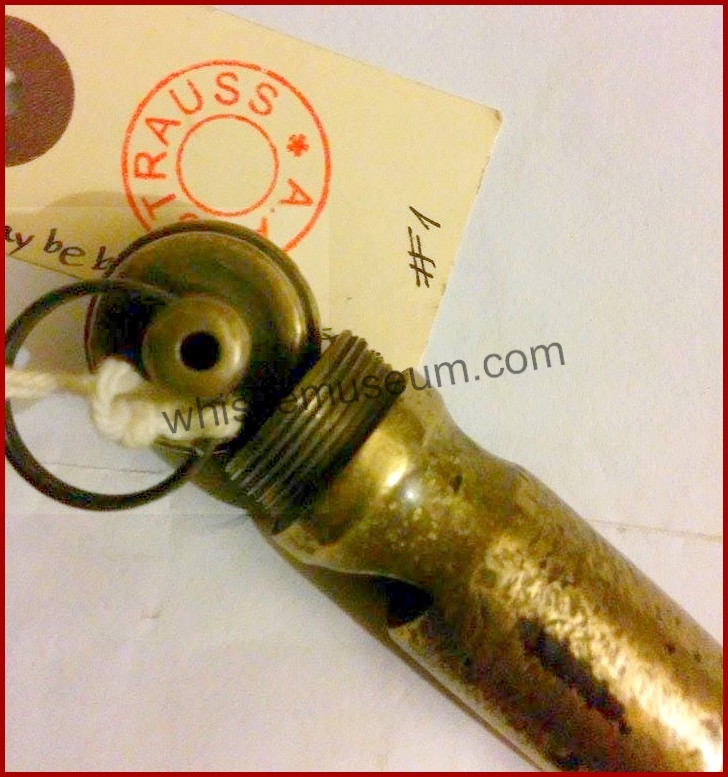
I am convinced that Thomas Dowler made whistles earlier as well and George kept making whistles but Thomas making whistles is not supported by any finds.
Advertisement 1858 Includes French Calls.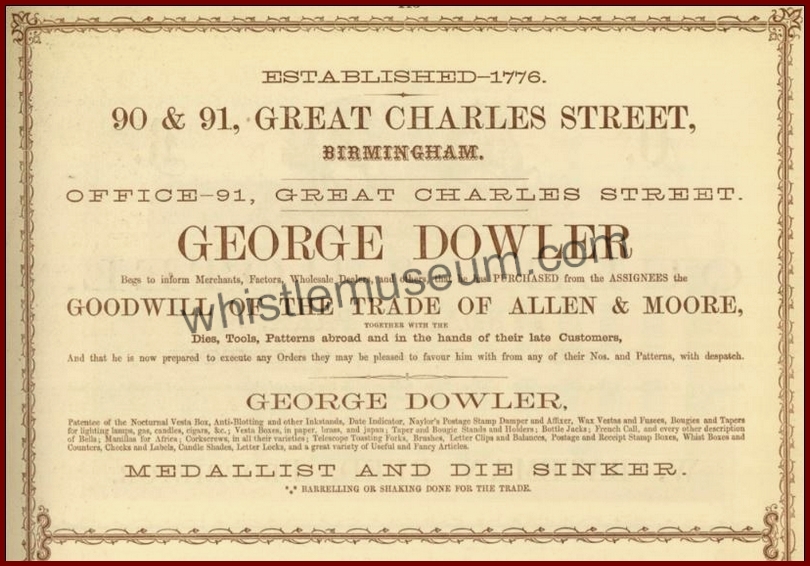
Few important dates for George Dowler
1850 Night serenade registered design.
1852 Crystal Palace Exhibition
1856 adv. upon purchasing Allen & Moore (See Photo)
and note making FRENCH CALLS whistles among many other things.
1861 George Dowler is flourishing and one of only 20 Birmingham manufacturers to employs over 500 workers.
1862 International World Fair. (See photo & paper review)
1862 A major fire on July 10 at Great Charles Street.
1868 Death of his aunt which starts legal fights with his brother William
about inheritance.
1870 Fatal fire which destroys his factory.
1871 Bankruptsy
1876 End of court case about the inheritance which leaves 94 Gt Charles st and other assets with his older brother William.
1876 George Dowler immigrates, with his wife & Children, to Canada to become a farmer.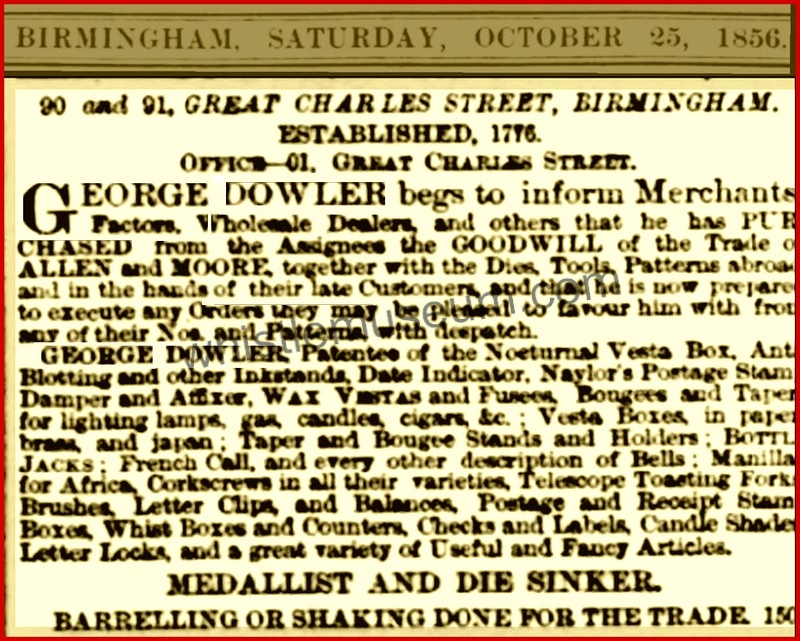
A photo from the exhibition of 1862 and a following newspaper review June 17, 1862.
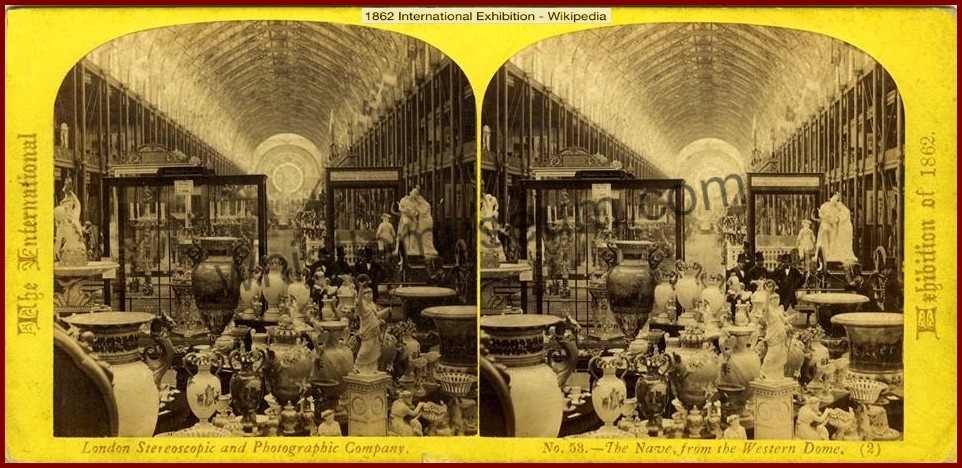
Birmingham Daily Post Tuesday, June 17, newspaper clip including a review of George Dowler display including Carriage & Door alarms, railway guards & dog whistles as well as the mentioned French whistles.
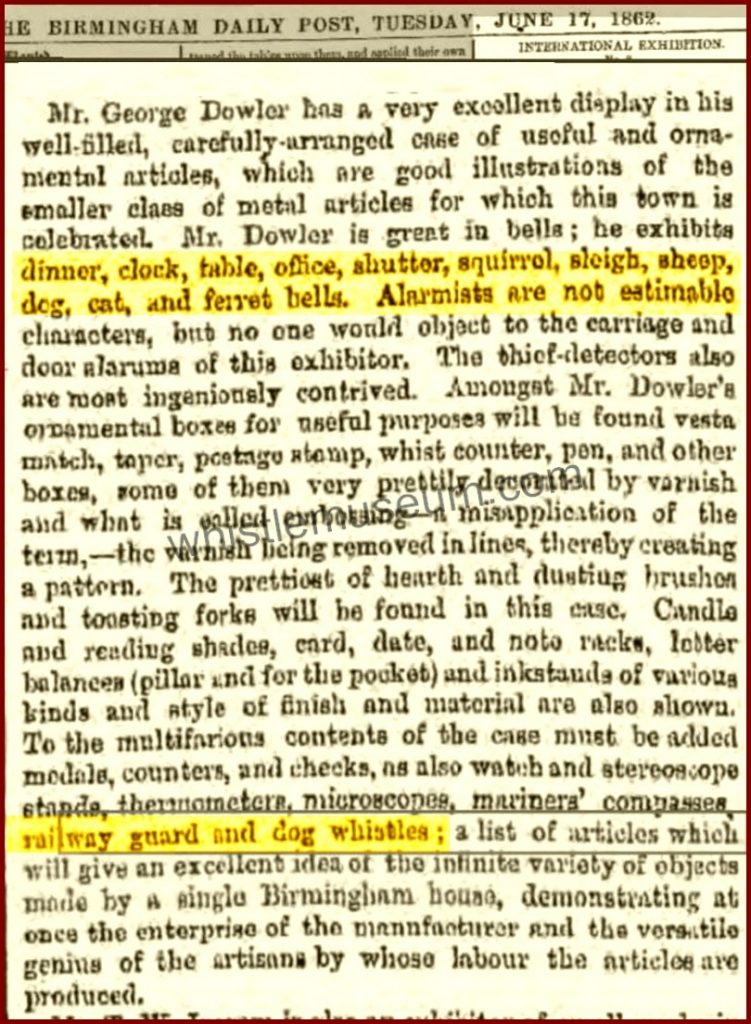
In 1862 the brothers were running two different factories and making different
goods but some were parallel, as we can see from this 1862 adv. in a directory.
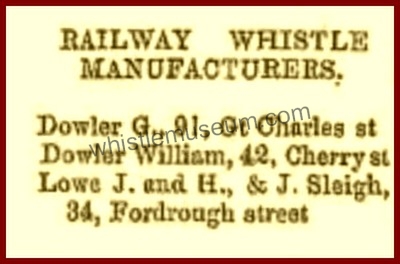
1862 Fire at Great Charles Street, on 10 July, 1862, A Birmingham newspaper,
part of a long paragraph about a Fire in 91 Great Charles st.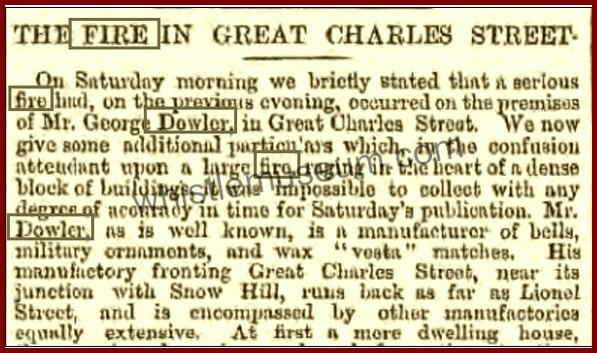
In the 1860s G. Dowler was manufacturing ammunition as well and having an office in London, Here is a 1868 Cartridge Shells box.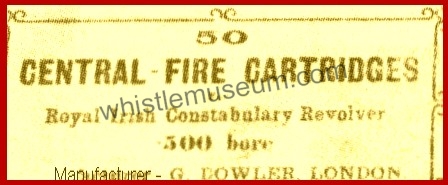
1870, 19th, March, THE BIG FIRE from a Birmingham newspaper
(The Illustrated Midland News).
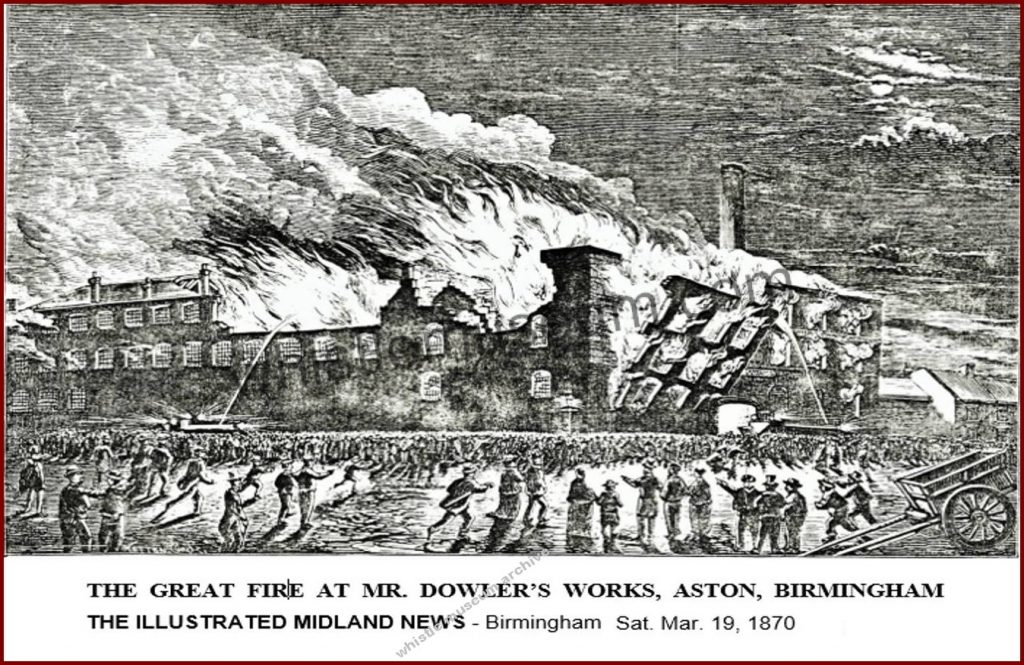
More quotes from reading at the library;
Legal Matters Following Ann Robbins Dowler death in 1868. In 1868 a series of legal disputes with his brother William over the inheritance of the Dowler works started and carried up to 1876.
George Dowler Works, – William Dowler, military ornament and button maker of Birmingham, challenged George for control of the estate. In a rare instance two probates were proved independently by George and William.
Ann Dowler had made several changes (codicils) to her will and in the final form William had joined George as executors of Ann’s estate. The dispute developed and in the Court of Chancery, the Great Charles Street Brass Foundry was offered for sale. It was a dispute that rumbled on through 1868 and 1869 to 1871 when William Dowler brought further actions and the matter was not finally settled until 1876.
George Dowler works were the largest firm producing phosphorus matchsticks, this along with making ammunition was fatal when the fatal fire destroyed Dowler Works, known as Plume works, in Aston, 90 & 91 Gt Charles St. Birmingham.
William Dowler continued the button making business in Birmingham, whilst Cannot & Vallance acquired the Plume Works and the Tyburn Cartridge sheds.
Gustavus Augustus Cannot was also in partnership in London with a Mr Bravington. Cartridge making was continued from 1871 through to 1872, but then ceased.
Cannot then sought to sell off the Plume Works. Various problems delayed the sale until 1876, when the Plume works was finally sold to Greenway, Clive & Vale of the Peoples Hall Works in Princip Street who converted the premises to a lock and hinge factory.
1871 Suspension note of GEORGE DOWLER PlumeWorks; 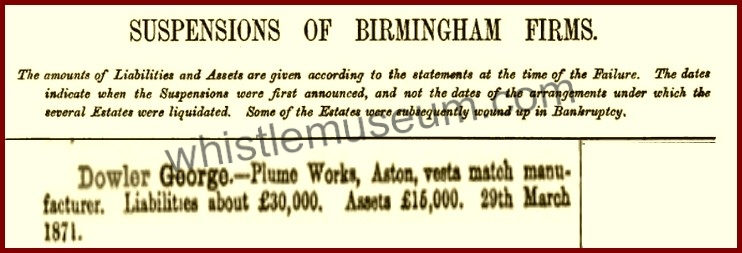
The first half of the 1870s was clouded by legal fights over Ann Robbins Dowler will .
It ended in favour of William Dowler and following that in 1876 George left to Canada to become a farmer.
Here is an anecdote from a newspaper clip (shared with us by P. Owen)
that will serve us as pivot point to depart from George Dowler who actually emigrated to Ontario Canada to become a farmer, in the same year as this event took place 1876, and switch to the history of his Brother William, In PART 3.
.”Nice story of William and George Dowler. They were visiting Pershore in Worcestershire when they came across some wandering minstrels. They performed a song, for which they were paid 5d. (That was a lot). George asked if he could play on their piano (which must have been a fairly small portable one). He started playing but commented on the poor quality of it. One of the minstrels took exception and a big fight broke out. Punches were thrown at William and George ended up in a ditch with the end of his finger nearly severed. George emigrated later that year (1876)] ”
Continue to PART III
* The article I wrote 2008, 2009 and posted in the Wikipedia was erased and found its way with few other articles copied from there and from this blog to a book about whistle makers in England sold on Amazon by an anonymous writer. That is I guess the nature of the internet, when it is not a hard copy book.]
All rights reserved A. Strauss
